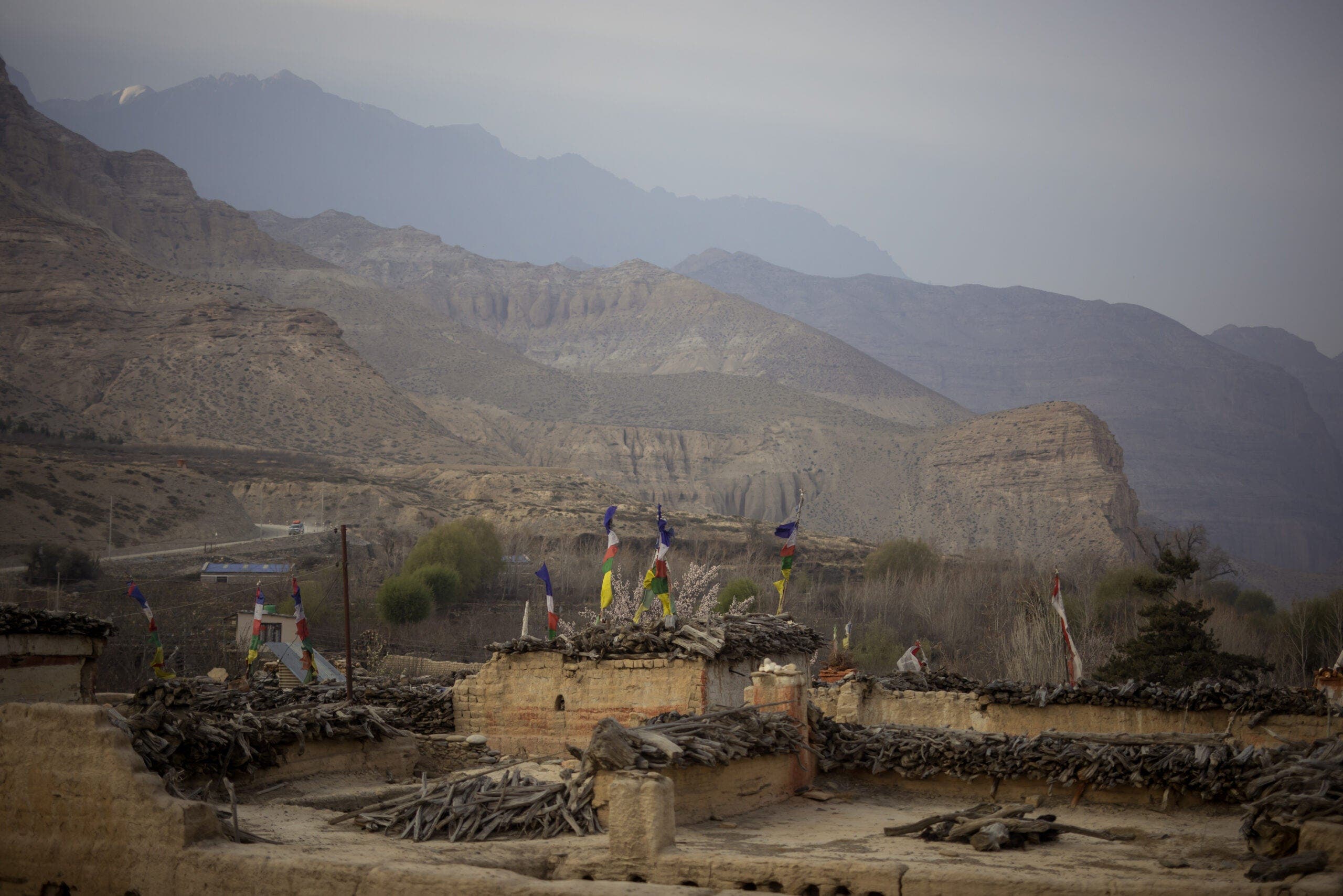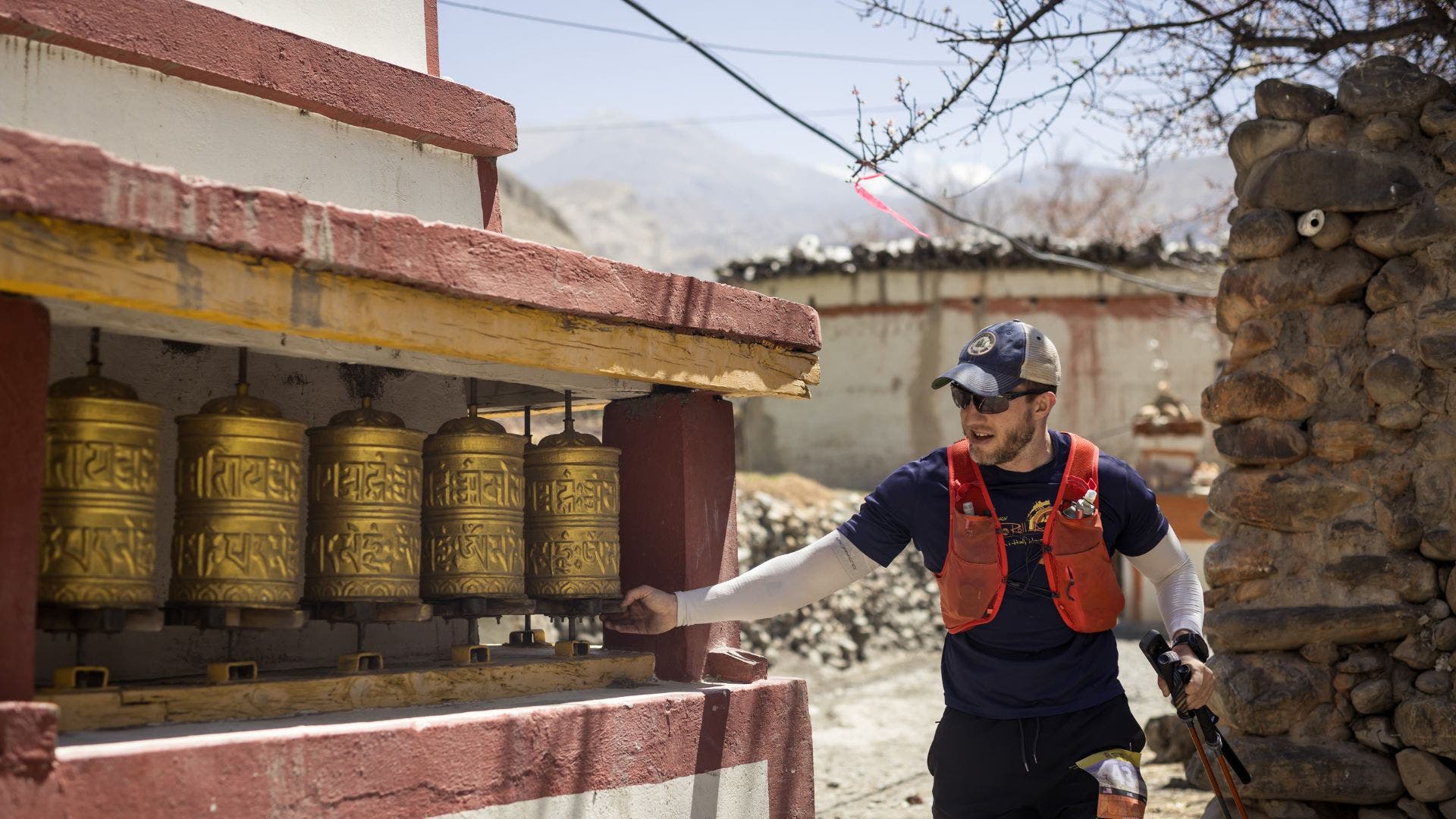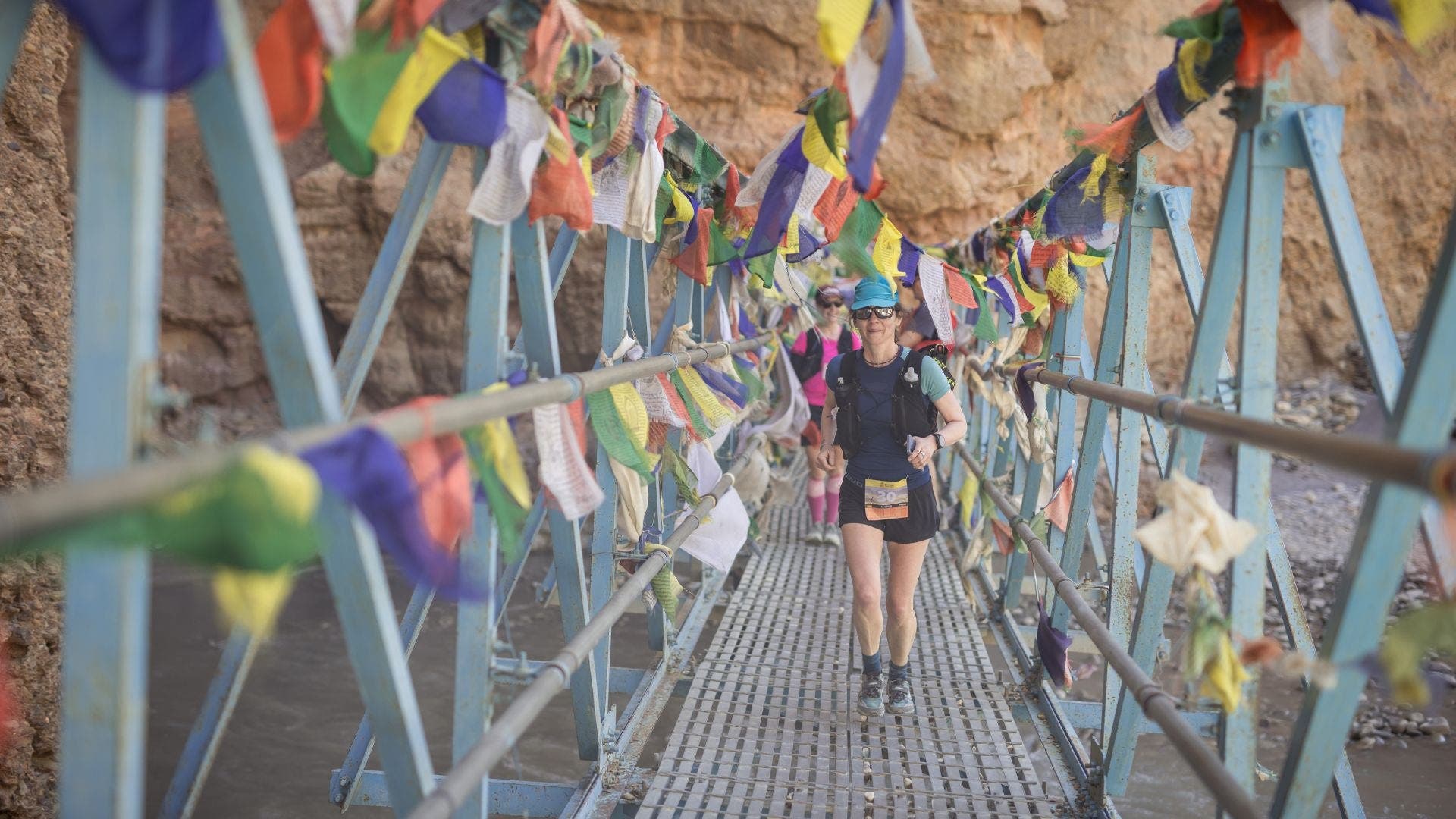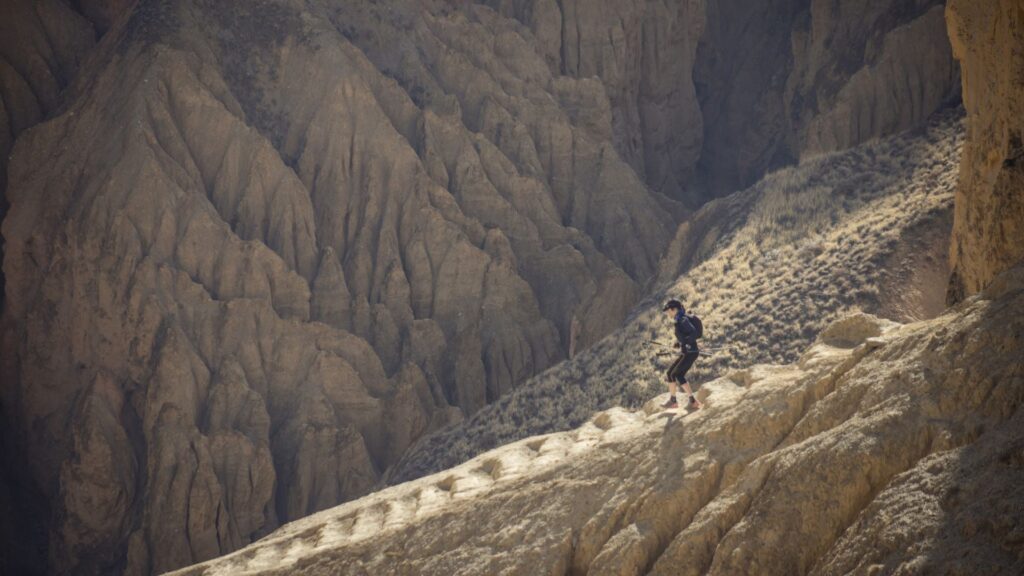Updated October 31, 2025 02:18PM
Ancient lore holds that Guru Rinpoche, the legendary tantric master who brought Buddhism to Tibet, chased a demon into the Mustang region of Nepal.
The guru and demon clashed against snowy peaks, barren canyons, and dusty trails until the guru finally prevailed in gruesome fashion, scattering the demon’s entrails and blood across the landscape. For his work, we now have the towering red cliffs that surround the village of Yara and its collection of flat-roofed, whitewashed adobe brick abodes topped with dried branches stacked together like Lincoln Logs.
This tale sets the scene for the fifth stage of the Mustang Trail Race–an annual eight-stage event totaling 105 miles with roughly 29,000 feet of elevation gain at high altitudes regularly eclipsing 13,000 feet. It’s an adventure that takes runners and hikers through culturally Tibetan villages of northern Nepal, where the heavens and earth collide to form one of the most fascinating, remote landscapes and cultural regions I’ve seen in my 15 years of trail running around the world.
Runners come from all over the world to race through the thin air and windswept canyons of Mustang. These include Nikhil Dinesh, who’s originally from India and now lives in Singapore, Americans Meaghan and Jason Geroux, and Canadian friends Scott Alm and Fraser Macmillan.
It’s Macmillan with the especially surreal connection to Nepal. He was in Kathmandu 10 years earlier when devastating earthquakes killed 8,962 people, including his parents, who were caught in an avalanche in Langtang National Park.
“Scotty was the most supportive friend for me there at that point,” Macmillan says. “He made himself available and showed up any which way.”
Like Macmillan, the other foreigners are here for reasons other than winning the race. It’s the Nepalis who are destined to prevail in their own relative backyard. For them, this is a step towards a career in professional trail running, following in the footsteps of Mira Rai, who finished fourth at the second edition of the Mustang Trail Race in 2014.
The child soldier-turned mountain running champion is a legend around here. Her story has inspired Nepalis and athletes around the world, leading to the creation of the Mira Rai Foundation in Kathmandu — an NGO committed to supporting trail running and the trail-running community in Nepal.
Lokendra Rai (no relation), Ang Furba, and Prabin Tamling are among the young Nepalis invited by race director Richard Ball to compete in the Mustang Trail Race.
“In a period of a week or so, they get eight chances to race,” Ball says. “That means a lot of practice, a lot of things learned, and hopefully they’ll be better for it.”

The Mustang Trail Race
Ball is the English-born co-founder and race director of the Mustang Trail Race. He first visited Nepal over 25 years ago, and it left a big impression on him. He returned 10 years later and eventually settled in Kathmandu. Now based in Southern California with his American wife and young child, Ball jokes that the race is his vacation.
He’s a playfully antagonistic host. During his opening briefing in Pokhara, he admitted that hurling insults is his self-defense mechanism when feeling nervous, and throughout the trip, he would often bite his tongue, audibly telling himself, “No, don’t say that.” Then, he’d tease the race doctor, Aakas Sherpali, for looking more like a DJ than someone you’d want dispensing medical advice. With his trucker hat, casual clothes, and bright 27-year-old smile, he did kind of prove Ball’s point.
But this is all part of Ball’s charm—and race participants love it. Some are repeat runners, having first participated in Ball’s seven-stage Manaslu Trail Race. Nightly briefings often feel like improvised stand-up comedy routines.

As we reach altitude, Ball describes how the thinner air can have an impact on things like your gastrointestinal tract. You might feel, let’s say, fuller. His advice? Fart freely and frequently to avoid discomfort.
With help from race organizer Neer Lalit Priya, whose brother co-created the race with Ball before pulling a life audible and becoming a Buddhist monk, they manage a team of 15 staff. Someway, somehow, this team moves an entire kitchen staff from guest house to guest house, preparing a seemingly bottomless pit of meals for breakfast, lunch, and dinner. Porridge, eggs, and toast are typical for breakfast. For lunch after each stage, there are a variety of soups (noodle, mushroom, garlic), and almost always a different dinner–spicy spaghetti, pad thai, and of course, dal bhat, the national dish of Nepal, usually comprised of steamed rice (bhat) with a lentil stew (dal) alongside seasonal vegetables, like potatoes and spinach. Dal bhat is the exclusive dinner of choice for the Nepali runners.
Spinning the Prayer Wheel
The Mustang Trail Race starts in Kagbenia—Mustang village on the Kali Gandaki River. An ancient forbidden kingdom nestled by the Tibetan Plateau and some of the tallest peaks in the world, Mustang didn’t allow tourists until 1992 and formally joined the contemporary Federation of Nepal in 2008. Visiting now requires a $500 permit (included in the race fee).
On the first morning of the race, we’re guided through town, past Hindu worshippers performing pujas, a ritualistic act of worship, and stop at a 15th-century monastery of Sakya Tibetan Buddhism. The reddish-orange stone building looks like a giant Lego block pressed into the earth.
The race start is casual. Furba spins the prayer wheels surrounding the base of the monastery. Spinning the prayer wheel is meant to build good karma and recite the mantra written thereon. Eventually, others, myself included, follow suit. Buddhist or not, it certainly can’t hurt.

We start running. The only bit of paved road comes at the very beginning of the first stage–evidence of the region’s increasing development. But it isn’t long before the trail turns to crushed gravel. Almost always surrounded by bare, desolate mountains.
In Michel Peissel’s 1968 memoir Mustang: A Lost Tibetan Kingdom, the author explains that locals saw such lifeless landscapes as a sign of unhappiness because beauty correlates with happiness. But for my money, I’m in paradise, perhaps owing to the stark juxtaposition with my day-to-day life in Berlin and the lush pine tree forests where I usually run.
To me, this barren landscape is beautiful—and we’re only going deeper into Mustang.

Altitude Blues
As a solid middle-of-the-packer, I never enter these races to try and win. I’d sooner find the demonic heart of the aforementioned Guru Rinpoche’s nemesis. So I’m especially chuffed when, despite battling a lingering groin injury and my skittish descending, I finish 12th out of 53 participants following the first stage from Kagbeni to Tsaile.
But the higher we climb, the farther I drop. During a rest day after Stage 3, I started feeling a scratchiness in my chest with bouts of fatigue. Stage 4 is a 16-mile loop with 2,800 feet of gain that reaches as high as 13,800 feet in altitude. I feel completely drained of energy throughout the day, unable to even muster a slow jog on the flats. I’m the inflatable tube man someone forgot to pump, sucking air through a straw.
Back at the hotel, other runners share similar race reports of struggling to move with any kind of speed–even on otherwise runnable terrain. So I chalk it all up to the inevitability of throwing a flat-lander urbanite into the heavens. Then, on the Stage 5 run to Yara, which is supposed to be a comparatively easy day with just 9.3 miles and 2,300 feet of gain, I crumble. As we start the first climb, I feel like a vacuum cleaner is sucking all the air out of my lungs. I quickly slip to the back of the pack.
At the top, I decide I need to call it a day. I sit down on a bench next to a string of prayer flags flapping in the wind and take out my phone to let the race director know that I’m dunzo. But before I can officially throw in the towel, I run into Canadians Grant Monette and Sandy Ng. Monette had been having similar breathing issues with a nasty cough, so he slowed to a hike and joined forces with Ng, the race caboose.

“We’re going slow if you want to join us,” Monette says.
Mentally, I like the idea of at least finishing five of the eight stages. So after some light, friendly badgering, I agree and proceed along the trail for what ends up being the hardest thing I’ve ever done in my life. Ball later says he could see us off in the distance, moving at a snail’s pace up the 150 stone stairs near the end of the stage.
”You looked like you were climbing Everest,” he says, mimicking my slow shuffle.
I collapse into my guesthouse bed as quickly as possible. Once I’m conscious long enough for an examination, the race doctor, the aforementioned DJ Sherpali, examines my lungs. He diagnoses me with pneumonia. I’m given antibiotics straight away, and my race is over.
A Frolicking Finish
I spend the next two days traveling by jeep with the crew, quickly regaining nominal strength thanks to the drugs. By the end of Stage 7, I ask Dr. Sherpali to have another listen to my lungs in hopes that I could at least slowly hike the final stage. It’s just a little over 10 miles. Sure, there’s a nasty five-mile climb with almost all of the day’s 4,100 feet of elevation gain, but I feel it in my kishkes that I can get to the top and roll on down to the finish line.
Perhaps sensing my desperation to finish on a high note, he gives my lungs a listen. There’s still something going on in there, but I get the green light for a slow hike.
The final stage begins like all the others: we gather near a makeshift banner, and Ball sends us off after a quick briefing. I have to restrain myself from slipping into a modest jog from the start. Fortunately, the terrain doesn’t give me much choice early on, launching into some absurd gradients as steep as 36 percent—essentially a wall.
Pulling my buff over my nose and mouth proves to be a game-changer. Ball suggested it during my Odyssean struggle on Stage 5, saying that the trapped moisture from the exhale will help soften the sting from Mustang’s harsh, dry air. I realized at that moment that I’d seen the Nepali runners similarly pull their own buff up when running through particularly windy and dusty sections of the trail, offering some buffer between their lungs and inhaling the dirt swirling in the air when pushing themselves.
Eventually, I make it to the summit, 6.5 miles into the stage. The wind whips across the peak, marked as per usual around here with a pile of stones and colorful prayer flags tied to the top like sails on the mast of a ship. From there, the pink trail ribbons run down the mountainside. The urge to run is overpowering. When will I be in a place like this again?
I must frolick.
I allow my legs to run as the trail permits. I don’t push myself. I don’t want to move too fast, and not just because of that pesky chest infection. I’m thinking of something Ball told me during our chat.
“We’ve come to a very special place,” he said on those steps in Chhusang. “The idea of trying to run as fast as possible through them is a bit crazy.”

Indeed, what a pity it would’ve been if my strongest memories were of trying to beat the runners ahead and behind me rather than soaking in the scenery that surrounds me.
So my eyes drink it all in one last time: the crisp blue sky, the waist-high brush showing signs of life on the otherwise arid countryside, both the makeshift wooden and canyon-crossing steel suspension bridges, the locals washing their laundry with the trailside water fountains, the quiet stone-covered villages, and the overwhelming sense of carefree freedom hanging in the air. I try to absorb it all as I reach the finish line in Muktinath, a town that pulls you back into civilization thanks to its place as a Hindu and Buddhist pilgrimage site drawing in tourists by the busload.
Reflecting and Changing
The other 30-some-odd runners who already finished are upstairs at the restaurant of the Hotel Bob Marley, where local legend says the reggae rock star once dined. I sit down with Tamling, who came from behind to beat Lokendra Rai by just five minutes in the cumulative total with a time of 16:22:27.
Tamling says he’s still relatively new to the sport, so much so that the difficulty of the race surprised him. To be fair, Ball invited him just one day before we departed for Pokhara, leaving no time for race-specific training. And although he lives in Kathmandu, the elevation is much lower than the highest points of the Mustang Trail Race. So even he struggled with breathing while pushing himself to keep up with Rai.
Furba, meanwhile, won the women’s race in 23:55:20–nearly four hours ahead of the next woman.
“I’m very excited,” Furba says, slipping into an ear-to-ear smile.
While only two runners are crowned winners, the rest of us take something home with us, too. (Besides this pesky lung infection.)
“I think any travel experience gives you the opportunity to reflect on your own life,” Ball says. “You’re seeing something completely different in front of you. Different kinds of people doing different kinds of things in a different way in a different landscape. And if you’re able to observe carefully, then maybe it’s going to give you a chance to reflect on your own life and maybe make a change.”


